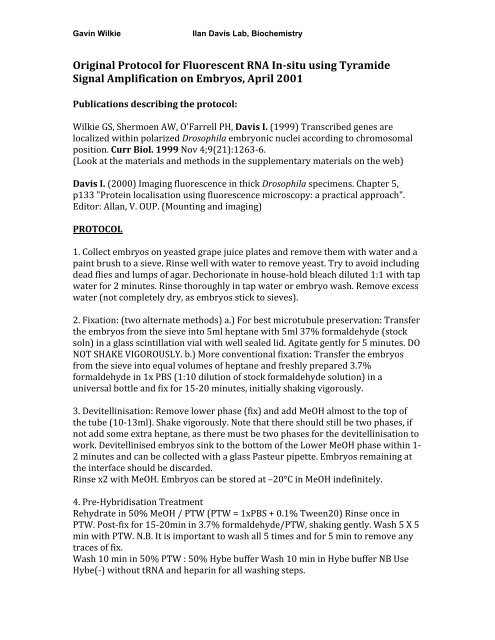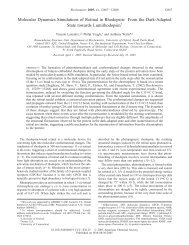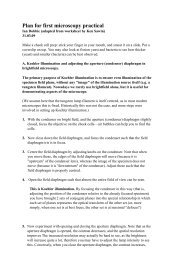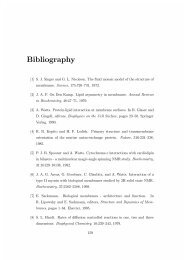Original Protocol for Fluorescent RNA In-situ using Tyramide Signal ...
Original Protocol for Fluorescent RNA In-situ using Tyramide Signal ...
Original Protocol for Fluorescent RNA In-situ using Tyramide Signal ...
You also want an ePaper? Increase the reach of your titles
YUMPU automatically turns print PDFs into web optimized ePapers that Google loves.
Gavin WilkieIlan Davis Lab, Biochemistry <strong>Original</strong> <strong>Protocol</strong> <strong>for</strong> <strong>Fluorescent</strong> <strong>RNA</strong> <strong>In</strong>-<strong>situ</strong> <strong>using</strong> <strong>Tyramide</strong> <strong>Signal</strong> Amplification on Embryos, April 2001 Publications describing the protocol: Wilkie GS, Shermoen AW, O'Farrell PH, Davis I. (1999) Transcribed genes are localized within polarized Drosophila embryonic nuclei according to chromosomal position. Curr Biol. 1999 Nov 4;9(21):1263-‐6. (Look at the materials and methods in the supplementary materials on the web) Davis I. (2000) Imaging fluorescence in thick Drosophila specimens. Chapter 5, p133 "Protein localisation <strong>using</strong> fluorescence microscopy: a practical approach". Editor: Allan, V. OUP. (Mounting and imaging) PROTOCOL 1. Collect embryos on yeasted grape juice plates and remove them with water and a paint brush to a sieve. Rinse well with water to remove yeast. Try to avoid including dead flies and lumps of agar. Dechorionate in house-‐hold bleach diluted 1:1 with tap water <strong>for</strong> 2 minutes. Rinse thoroughly in tap water or embryo wash. Remove excess water (not completely dry, as embryos stick to sieves). 2. Fixation: (two alternate methods) a.) For best microtubule preservation: Transfer the embryos from the sieve into 5ml heptane with 5ml 37% <strong>for</strong>maldehyde (stock soln) in a glass scintillation vial with well sealed lid. Agitate gently <strong>for</strong> 5 minutes. DO NOT SHAKE VIGOROUSLY. b.) More conventional fixation: Transfer the embryos from the sieve into equal volumes of heptane and freshly prepared 3.7% <strong>for</strong>maldehyde in 1x PBS (1:10 dilution of stock <strong>for</strong>maldehyde solution) in a universal bottle and fix <strong>for</strong> 15-‐20 minutes, initially shaking vigorously. 3. Devitellinisation: Remove lower phase (fix) and add MeOH almost to the top of the tube (10-‐13ml). Shake vigorously. Note that there should still be two phases, if not add some extra heptane, as there must be two phases <strong>for</strong> the devitellinisation to work. Devitellinised embryos sink to the bottom of the Lower MeOH phase within 1-‐2 minutes and can be collected with a glass Pasteur pipette. Embryos remaining at the interface should be discarded. Rinse x2 with MeOH. Embryos can be stored at –20°C in MeOH indefinitely. 4. Pre-‐Hybridisation Treatment Rehydrate in 50% MeOH / PTW (PTW = 1xPBS + 0.1% Tween20) Rinse once in PTW. Post-‐fix <strong>for</strong> 15-‐20min in 3.7% <strong>for</strong>maldehyde/PTW, shaking gently. Wash 5 X 5 min with PTW. N.B. It is important to wash all 5 times and <strong>for</strong> 5 min to remove any traces of fix. Wash 10 min in 50% PTW : 50% Hybe buffer Wash 10 min in Hybe buffer NB Use Hybe(-‐) without t<strong>RNA</strong> and heparin <strong>for</strong> all washing steps.
Gavin WilkieIlan Davis Lab, Biochemistry Prehybridise at least 1 hour in Hybe buffer at 70°C (on a heat block or in an oven) 5. Hybridisation Add Dig-‐<strong>RNA</strong> probe in Hybe (Usually diluted 1:1000, but test dilution <strong>for</strong> optimal results) to embryos <strong>using</strong> at least 100µl of probe making sure embryos are well covered and mixed with the probe. Leave overnight at 70°C (on a heat block or in an oven) 6. Washes: <strong>In</strong> morning remove and save probe (it can be used several times but does get diluted each time). Wash as follows (at 70°C, warm up solutions first; no need to agitate): 1 X 30 min Hybe 1 X 30 min 50% Hybe / 50% PTW 4 X 30 min PTW BLOCKING STEP (not normally required) incubate in TNB <strong>for</strong> 1 hour 7. Antibody: <strong>In</strong>cubate embryos in 1:1000 Sheep anti-‐Dig POD (Horse Radish Peroxidase) coupled antibody (Boehringer Mannheim Cat no. 1 207 733) in PTW. Rock the tubes on a rolling incubator <strong>for</strong> at least 1 hour. NB Can include fluorescently labelled Wheat Germ Agglutinin (Molecular Probes, 1/1000) during this step or at the end of the procedure to stain nuclear membranes (binds to NPC’s). 8. Washes: Remove antibody (can save and reuse) Wash 3 X 20 min with PTW. 9. TSA Detection Be<strong>for</strong>e going on to do the <strong>Tyramide</strong> <strong>Signal</strong> Enhancement, it is a good idea to check the in-‐<strong>situ</strong> has worked <strong>using</strong> the DAB substrate <strong>for</strong> HRP. Remove a small amount of embryos to a microtitre plate and stain with DAB. The signal should be visible within minutes. The TSA signal is not visible, so staining intensity can only be controlled by staining <strong>for</strong> different lengths of time and evaluating the sample in the fluorescent microscope. However, the time taken to see a good DAB signal is roughly equivalent to the time <strong>for</strong> a good TSA signal. For each sample, Dilute 2μl of the <strong>Fluorescent</strong> <strong>Tyramide</strong> stock solution (NEN) into 100μl of Amplification Diluent (supplied with kit). Remove as much PTW from the embryos as possible and add the TSA. <strong>In</strong>cubate <strong>for</strong> 1-‐5 mins depending on level of staining required. 10. Stop reaction by washing 3 x 5 mins with PTW. Can then stain with other antibodies (e.g. anti-‐tubulin monoclonal, or Wheat Germ Agglutinin) It is often useful to stain with DAPI at this point -‐ Use 10 times the normal amount (e.g. 1/1000 dilution of 1mg/ml stock)
Gavin WilkieIlan Davis Lab, Biochemistry 11. Mount embryos in 80% Glycerol or Vectashield and seal the slide with clear nail varnish. Keep slides at 4°C in dark when not in use. The Fluorescence is covalently deposited at the site of HRP reaction and so should not diffuse away over time. REAGENTS REQUIRED TSA kit supplied by NEN Life Science Products (UK 0800 896046) ; also see http://www.nenlifesci.com <strong>for</strong> more info.) We use the Cy3 kit (NEL734A) but kits <strong>for</strong> Cy5, fluorescein, rhodamine and coumarine labelling are also available. TNB is 0.1M Tris (pH7.5), 0.15M NaCl and 0.5% Blocking reagent from NEN kit. PTW is PBS + 0.1% Tween20. Hybe solution: 50% deionized <strong>for</strong>mamide 5X SSC 100 µg/ml E. coli t<strong>RNA</strong> (Sigma) 50 µg/ml heparin 0.1% Tween 20 pH to 6.5 with conc. HCl Making Probe: Transcribe <strong>RNA</strong> probe <strong>using</strong> Boerhinger Mannheim <strong>RNA</strong> Dig labeling kit. The template can be from miniprep DNA (E.coli <strong>RNA</strong> is o.k.) and must be linearised with an appropriate restriction enzyme (<strong>for</strong> sense or anti-‐sense probes) and enzyme heat killed. Use about 1 µg of digest (no more than 2.5 µl) in 20μl probe reaction) Transcription reaction mix: Linearised template (0.5mg/ml) 2μl NTP labelling mix (tube 7) 2μl 10x buffer (tube 8) 2μl RNase inhibitor (tube 10) 0.5μl ddH2O (DEPC) 11.5μl <strong>RNA</strong> polymerase (T7/T3/SP6) (20U/ml) 2μl <strong>In</strong>cubate at 37° <strong>for</strong> 2h. Stop reaction by adding 2µl of 0.2M EDTA. Check yield on gel: load 0.5-‐1μl be<strong>for</strong>e and after incubation. Should see strong novel <strong>RNA</strong> band as reaction should yield about 10μg DIG labelled <strong>RNA</strong>.







